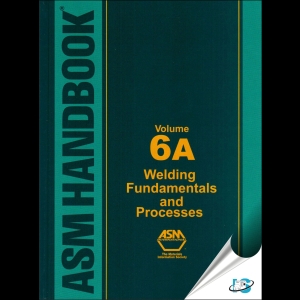A focused revision of the welding process information in Volume 6: Welding, Brazing and Soldering (1993). Updated and expanded articles on the fundamental principles of welding, including heat transfer, solidification, residual stress, and distortion. Workhorse methods of arc and resistance welding, friction stir welding, laser beam welding, explosive welding, and ultrasonic welding.
ASM Handbook, Volume 6A: Welding Fundamentals and Processes is a focused revision of the welding process information in the 1993 Volume 6: Welding, Brazing, and Soldering. The new volume expands on the fundamental principles of welding, including heat transfer, solidification, residual stress and distortion, and has an all-new section on modeling and simulation of welding processes. Articles cover all welding processes, from the workhorse methods of arc and resistance welding, to newer methods like friction stir welding and laser beam welding, to specialty methods like explosive welding and ultrasonic welding. One-third of the articles are all-new, and welding articles from the 1993 edition have been updated and expanded, making this volume the most complete reference source anywhere on welding fundamentals and processes. From theory to practice, the book is a comprehensive resource for evaluating and selecting welding methods, working with vendors, understanding how processing variables affect welding outcomes, and more.
FUNDAMENTALS OF WELDING
An Overview of Joining Processes
Overview of Welding Processes
FUNDAMENTALS OF FUSION WELDING
Welding Process Fundamentals
Characterization and Modeling of the Heat Source
Nature and Behavior of Fluxes Used for Welding
Heat Flow in Fusion Welding
Factors Influencing Heat Flow in Fusion Welding
Transfer of Heat and Mass to the Base Metal in Gas Metal Arc Welding
Fluid Flow Phenomena during Welding
Fundamentals of Weld Solidification
Dilution in Fusion Welding
Solid-State Transformations in Weldments
Thermomechanical Effects of Fusion Welding
Residual Stresses and Distortion
FUNDAMENTALS OF SOLID-STATE WELDING
Mechanisms of Bonding for Solid-State Welding Processes
Fundamentals of Friction Welding
Fundamentals of Friction Stir Welding
Fundamentals of Ultrasonic Welding
Fundamentals of Solid-State Resistance Welding
Fundamentals of Diffusion Bonding
Nondestructive Evaluation of Solid-State Welds
Mechanical Properties of Soft-Interlayer Solid-State Welds
ARC WELDING PROCESSES
Introduction to Arc Welding
Arc Physics of Gas Tungsten and Gas Metal Arc Welding
Qualification of Welding Procedures and Personnel
General Design Considerations for Arc Welding Processes
Power Sources for Arc Welding
Arc Welding Process Control
Shielding Gases for Arc Welding
Shielded Metal Arc Welding
Gas Metal Arc Welding
Plasma Gas Metal Arc Welding
Hybrid Laser Arc Welding
Flux Cored Arc Welding
Submerged Arc Welding
Gas Tungsten Arc Welding
Gas Tungsten Arc Welding with Penetration-Enhancing Compounds
Plasma Arc Welding
Electroslag and Electrogas Welding
Stud Arc Welding
Capacitor Discharge Stud Welding
RESISTANCE WELDING PROCESSES
Introduction to Resistance Welding
Resistance Welding Power Supplies and Controls
Resistance Spot Welding
Projection Welding
Resistance Seam Welding
Flash Welding and Upset Welding
High-Frequency Welding
Procedure Development and Practice Considerations for Resistance Welding
Evaluation and Quality Control of Resistance-Welded Joints
HIGH ENERGY ELECTRON BEAM AND LASER BEAM WELDING
Introduction to High Energy Density Electron and Laser Beam Welding
Electron Beam Welding
Design Considerations for Electron Beam Welding
Nontraditional Applications of Electron Beams
Quality Control of Electron Beams and Welds
Laser Beam Welding
Laser Beam Weld Design, Codes, and Quality Assessment
Laser Beam Delivery Optics and Manufacturing Economics
Laser Deposition Processes
Laser Weld Quality Monitoring
Laser Cutting, Drilling, and Shock Peening
Microjoining with Laser and Electron Beams
SOLID-STATE WELDING PROCESSES
Procedure Development and Practice Considerations for Inertia and Direct-Drive Rotary Friction Welding
Process Monitoring and Control of Rotary Friction Welding
Development of Welding Procedures for Friction Stir Welding
Friction Stir Welding Tool Designs
Friction Surfacing
Diffusion Bonding
Explosion Welding
Forge and Coextrusion Welding
Magnetic Pulse Welding
Cold Welding
Roll Welding and Laser Roll Welding
Ultrasonic Welding
Ultrasonic Additive Manufacturing
FUNDAMENTALS OF WELD MODELING
Introduction to Integrated Weld Modeling
Modeling of Heat and Mass Transfer in Fusion Welding
Modeling of Thermal-Electrical-Mechanical Coupling in Fusion Welding
Modeling of Metallurgical Microstructure Evolution in Fusion Welding
Numerical Aspects of Modeling Welds
Modeling of Thermomechanical Phenomena in Fusion Welding
REFERENCE INFORMATION
Safe Welding Practices
Welding Fuels and Shielding Gases
Summary of Fusion Welding Processes
Weldability of Ferrous and Nonferrous Alloys
Preheat and Postweld Heat Treatment Temperatures for Selected Steels
Glossary of Terms: Welding Fundamentals and Processes
Abbreviations: Welding Fundamentals and Processes

